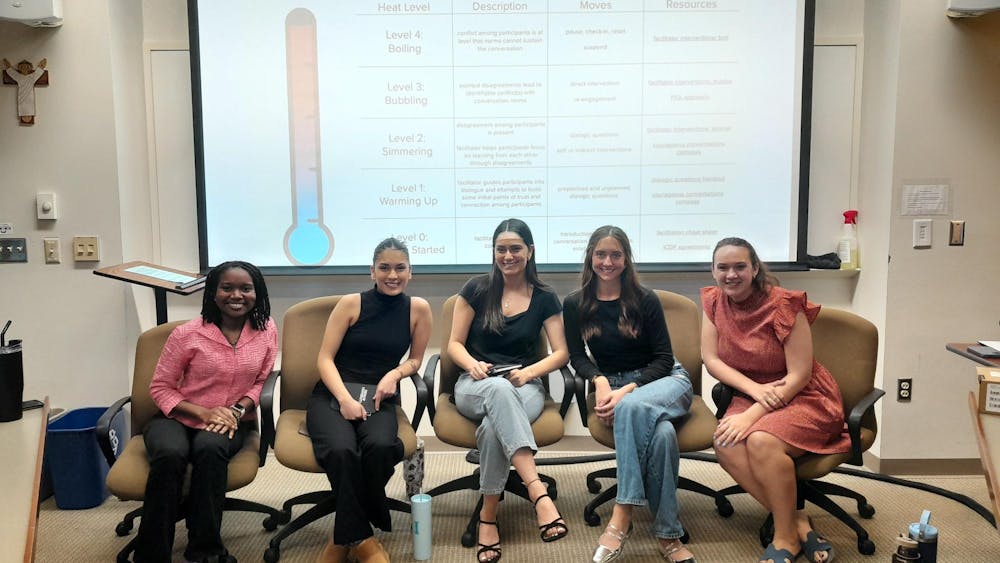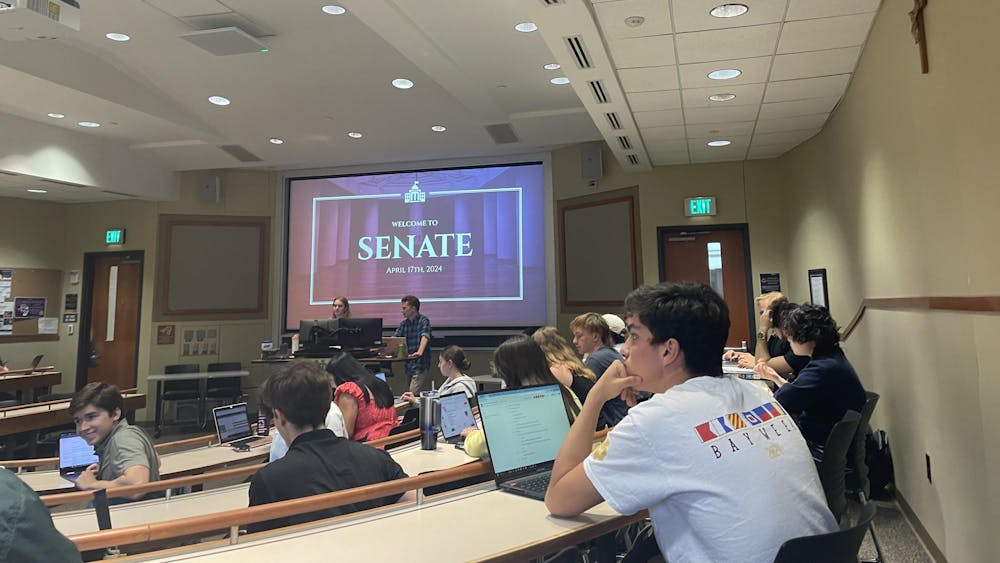Editor's note: This is the next installment in a five-day series discussing the role of women at Notre Dame and Saint Mary's, in honor of the 40th anniversary of coeducation at the University this year.
Long heralded as the driving force behind coeducation at Notre Dame, University President Emeritus Fr. Ted Hesburgh said he had simple reasons for opening the University to undergraduate women in 1972.

"When God made the human race he didn't just make men, he made men and women," he told The Observer this week. "So since this is considered the best Catholic university in the world ever, well, why shouldn't half the people here be women as well as men since women ... are just as important in the scheme of things as men?"
This clear-headed logic seems obvious today, but Hesburgh said his ideas were "heresy" to many Notre Dame supporters 40 years ago.
"They said, 'You're giving away the store. This is the greatest macho, male-dominated thing. ... The place will go soft. It won't amount to anything anymore,'" he said. "I said, 'Look, I'm in charge, and this is what I think is important. If we're going to be the greatest Catholic university, we should be open to women as well as to men.'"
Though he faced no overt opposition to the proposed inclusion of women, Hesburgh said the process of coeducation required extensive discussion and personal initiative.
"People didn't come out with battle axes trying to shut the place down or something. ... Like anything else that goes on in a university, [coeducation] got thoroughly discussed and there were pros and cons, but someone had to make the decision," he said. "I figured I was the president, so I made the decision that No. 1, we were going to be coeducational, and No. 2, women were going to have the same ... profile of excellence as the male students."
Hesburgh said he also thought women deserved access to personal space in dormitories separate from male students.

"Someone said, 'Well, let's put men and women in the same dormitories,'" he said. "I said, 'No, I think women have a life of their own and they can't really follow it if they've got men looking over their shoulders every hour of the day or night.'
"I can see where women can entertain men in the halls, but come midnight, the old bell goes off and the men leave, and the women get in their PJs and talk women talk. The space is all theirs."
Hesburgh spent 35 years in the Office of the President, leading Notre Dame from 1952 to 1987. But he said introducing coeducation to the University was the best decision he made in all that time.
"In any event, I moved ahead quickly, and I've never regretted it," he said. "I think women are holding their own here and putting together a very good record, of which I'm very proud."
'Impossible conditions'
Although Hesburgh's personal convictions about the role of women in University life propelled the transition to coeducation, the final decision came after long discussions with Saint Mary's College about a potential merger between the schools.
"We discussed it at the highest level of administration of both schools," he said. "We decided in principle we would like to merge the two schools. But you couldn't just do it because there were all kinds of overlaps of programs and things."
Administrators from both schools came close to approving the merger on several occasions, but Hesburgh said "impossible conditions" prevented Notre Dame from agreeing to merge with Saint Mary's.
"After two or three of these forays ... I said, 'Well, why don't we just say it's been an interesting discussion. We're still open to merge with Saint Mary's at any time. If you want to reopen the discussion that's fine, but there's no point getting into a discussion where one side has a strong power blocking every time we get close to a merger,'" he said. "That's where we are now."
More than 40 years after the proposed merger failed, Hesburgh said his feelings about the prospect have not changed.
"I was in favor of the merger and I think the superior general [at Saint Mary's] was in favor of the merger ... To this day, I favor joining, but I don't think it's necessary," he said. "I think we've become closer to [Saint Mary's] in many ways. ... I think we have the best of all worlds short of a merger, so I've been happy to see that develop."
Hesburgh said the mutually beneficial relationship between the schools is due in part to their shared history, beginning when Fr. Edward Sorin founded Notre Dame in 1842 and the Sisters of the Holy Cross followed suit in 1844.
"I think it's interesting that when Sorin began the school in those days, there were no mixed schools," Hesburgh said. "[Notre Dame] became a men's school, but only a year or so went by before [Sorin] asked the sisters to start a school on the other side of the road. Our history is almost identical ... and from [the 1840s] on, we've been close together and should be. [Saint Mary's] has been helpful to us and vice versa."
'A more normal human situation'
In the 40 years since undergraduate women first entered Notre Dame, Hesburgh has seen their successors make significant contributions to the University's intellectual, athletic and religious life, complementing the work of their male counterparts.
"Women more and more have had their say on campus. ... Men and women tend to think very much along the same lines at a Catholic university," he said. "I'd have to work hard to scrape up a problem [between men and women]. ... I think we get along as a happy family where we're both making good contributions to the good of the whole enterprise."
Hesburgh said he thinks the inclusion of women made the University a microcosm more representative of the world in general.
"Having women here makes it a much more normal human situation. ... It seems to me that year after year we get closer together instead of drifting apart," he said.
Indeed, the world outside Notre Dame had a major impact on coeducation and the University as a whole, especially in the midst of the Vietnam War, the civil rights movement and other political turmoil at home and abroad.
"The great national decisions that were going on ... all of these things that affected the world were bound to affect the University," he said. "I was very happy that the students were very active in world affairs and came at them from different points of view as men and women."
Though the political and social climate outside the University has changed considerably since 1972, Hesburgh said such a dynamic environment encourages Notre Dame students to consider their role in the world after graduation.
"I think [involvement in world affairs] was a good thing for education at Notre Dame because we don't want to be in another world," he said. "We want to be in the world that exists right now, we want to compete in that world and we want to be leaders in that world, and that's true of both men and women."












